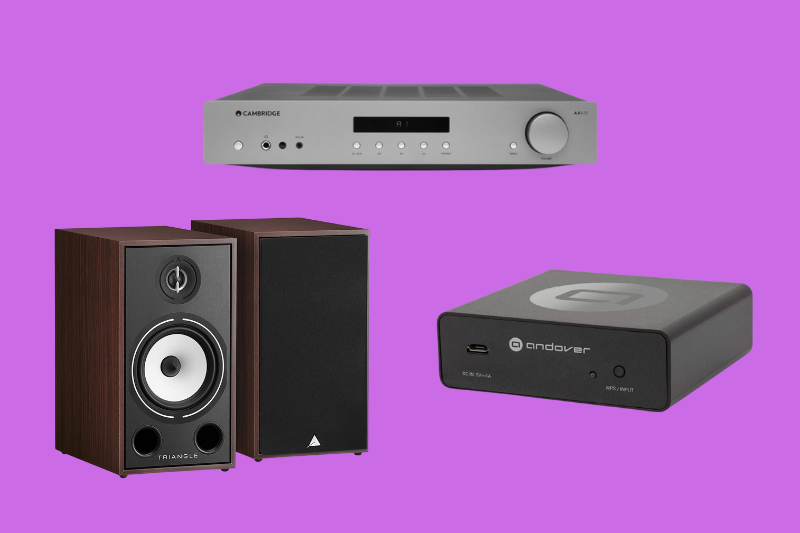You CAN build a wonderful budget audiophile setup!
If you’re reading this, then that means you most likely care about music. Not just music, but high-quality reproduction of music. That’s basically what Hi-fi (short for high fidelity) is all about. It’s about putting together a group of audio components to make a recorded piece of music sound as good as possible.
So how do you know what “good” sounds like? Well, most audiophiles, or Hi-fi enthusiasts, aim for what we call “realism” or “fidelity” (which means exact reproduction). What does that mean? Well, most of us have been to a live musical performance, and if you have, you probably have a good idea of what it means.
When we talk about “realism,” we talk about a hi-fi system that sounds as close to the “real thing” as possible, meaning a system that provides all the musical cues one would receive while listening to a band playing in front of them.
Those cues, meaning the details, dynamics, and spatiality of the performance, make the music move us and stir our emotions. It’s what myself and many other reviewers call “musicality,” which is what you want from a good hi-fi system overall.
A system’s ability to be musical is mainly dictated by its transparency (or clarity), plus its range, meaning its ability to cover the audible audio frequencies from top to bottom (upper treble to sub-bass). The system’s tuning or tonal balance also plays a part, amongst other things.
At Hifitrends, we believe the best way to achieve this is via a 2-Ch hi-fi stereo system comprised of a source, amplification, and a pair of speakers.
*Ad*
Note: We’re not against 2.1 systems that use a pair of speakers and a subwoofer, but we generally don’t consider systems that use more speakers than that (i.e. surround sound systems) part of hi-fi. That’s why we aren’t covering surround sound in this guide.
While it’s generally true that you will get better performance from a system as you move up in price, it doesn’t mean you can’t get musicality from an inexpensive system.
If you shop carefully and do a little research, you can get high-fidelity sound from an affordable system costing as little as $1000, or even less if you buy used.
The mission of Hifitrends.com is to help people put together affordable (usually less than $5k total) yet musical Hi-fi systems, and this article will walk you through the steps to make it happen!
Have a question about building an affordable hi-fi system? Drop us a line at info@hifitrends.com! We may feature your question on the site!
Here are the steps:
Step 1. Do Your Homework
Before picking out specific gear, you should figure out what you want your system to look like. This will be dictated by where you will place the system, how much room you have for the system, your budget, not to mention personal preference.
For example, you need to decide whether you want floorstanding or standmount speakers, usually based on your room’s size. If you have a larger than average room, you may need a bigger speaker to fill the room with sound. On the other hand, floorstanding speakers may “overload” the space with sound if you have a smaller room.

As far as cost is concerned, we feel a good pair of bookshelf speakers will usually (in an average-sized room) give you more bang for the buck.
You also need to pick your amplification. We usually suggest “solid-state” (usually class AB or Class D) 2 ch. Integrated amps for affordable systems because they provide the best bang for the buck in terms of features and sound quality.
Integrated Amps (esp. from established hi-fi brands) are explicitly designed for high-fidelity no matter what price point you purchase at.
They just get incrementally more transparent (more clarity) as you move up in price.
Pro Tip: If you have an average-sized room and speakers with a high sensitivity rating (think above 90-95db), you can most likely save money by purchasing a capable, high-current amp at a lower wattage rating. Most people overestimate how much wattage they need.

For example, the $350 Cambridge Audio AXA35 35 Watt 2-Channel Integrated Stereo Amplifier has more than enough juice to drive most high-quality bookshelf speakers to your preferred volume level. It’s a great component to build an affordable hi-fi system around.
Recommended Reading: How Much Power Do I need? (PS Audio)
Once you decide on speakers and amplification, you need to determine what sources you will use.
Today, most people use a Wi-Fi streamer connected to a music service like Qobuz. Still, others play music via Bluetooth (not recommended as a primary option), use a CD player, or play records on a turntable. Of course, you can also play music files from a computer. I’ve even heard of some people playing music via the optical output from a TV.
Rediscover your music in studio quality with Hi-Res streaming and downloads on Qobuz. Get a free trial now.
So as you can see, there are many different sources you can choose from.
Ed Note: Most people primarily use a Wi-Fi streamer (like the Bluesound Node), but I like to play CDs I pick up for $1 at the Goodwill. I like how CDs sound and have fun finding musical gems on the shelf. That means I also need a CD player which I have. In addition, I like to play vinyl every once in a while, so I have a modest manual belt-drive turntable. Most people putting together affordable systems aren’t as crazy as I am. Most stick to just one source, which is where I recommend starting.

An affordable Wi-Fi music streamer like the $149 Andover Audio Songbird will give you a lot of music for your money. It will play tunes from just about anywhere (DLNA Network Drives, Music Services, Apple Airplay, Bluetooth, etc.) and sounds pretty darn good.
If you don’t have much experience listening to Hi-Fi systems, this is also the time to go out and get some listening time in.
At this point, you’re not listening to purchase, but you’re listening to get an idea of what you like or value in a good-sounding music system. You’re also listening to build up your skill at recognizing and describing good sound in a system.
At this point, I also recommend you get educated about how reviewers and audiophiles describe good sound, so you know what to listen for.
Recommended Reading: “Learn the language of good sound” (Crutchfield)
Step 2. Set A Budget
Next, you need to decide how much you’ll spend on your system. You need to come up with a total amount you’re willing to spend and then break it up amongst the components.
No matter what you spend, we think you should put about half of your money on the speakers, almost half on the combination of amp and sources (great pieces like the $1200 Marantz 7000N Integrated Amp, with a streamer built-in, would count for both), then spend the rest on stands, cables, and a power conditioner –in that order.
For example, here’s our suggested breakdown for a $2000 system:
- 40% Amp/Sources- $800
- 50% Speakers- $1000
- 10% Accessories- $200
Step 3. Pick & Listen
Now that we have a budget, it’s time to go shopping! At this point, you need to pick the best gear for you based on the money you have and the information you gleaned during the homework stage.
At this point, you need to start browsing online retailers and look at the gear in your price range. Focus on the stuff that matches up with the game plan you created in step 1, and make a list of potential picks.
Once you have a list of picks, start looking at reviews (both professional and user) for that gear and determine what stuff you want to audition. This will help you narrow your list down further. Give the most weight to reviews written by reviewers that have similar values and musical tastes to your own.
When we talk about similar values, the reviewer wants the same things from a system as you do. For example, we love a lot of acoustic and jazz music on the site, so we use it in our reviews. That usually means we don’t put a lot of value in loud, bass-driven systems.

Instead, we value systems that play with nuance at low volumes, have a wide-open soundstage and sharp imaging. If you like similar traits when you listen, you should give our reviews more weight.
If you like to play rock music loud and are trying to duplicate the sound level of a live concert in your system, you should put more weight on reviews that value that. (Systems that do that well are usually quite expensive, by the way.)
You also want to note what gear people think goes well together. For example, you will usually find certain amp/speaker/source combos that people cite over and over, and those are generally suitable matches to check out.
Once you have your audition list, you want to listen to the stuff. If you have stores nearby, go there and listen to what you can. See what stuff moves you. If you have a specialty hi-fi dealer in your area, cherish them. They know what things work together, and if they are good, they may lend you some gear so you can hear it at home. They can also help you with upgrades later on.
Just keep in mind, don’t take stuff home unless you are serious about buying and have the funds. Also, if a dealer goes out of their way to help you, please purchase from that dealer. That’s what keeps them around to help you in the future.
That leads to our next point. There are fewer and fewer specialty hi-fi shops around today because people are buying stuff online. That means you may not have the opportunity to hear the things you want to hear in a showroom. Even if there is a showroom near you, unfortunately, they may not have the lower-priced gear on display, so you can’t hear it anyway.
Given that, you may have to purchase gear from an online retailer that has a liberal return policy then swap stuff in and out until you come out with a lineup you love.
Even if you can listen at the dealer, you still need to listen at home before making a final judgment on a system. If you hear something you like, ask if you can try it before buying.
Step 4. Setup
At this point, you should have your gear picked out and in your listening room, but you’re not done yet. Correct placement of speakers is critical as far as sound quality is concerned. Depending on the speakers you pick, an inch to the left or right can make a big difference. Most speakers come with detailed instructions on how to place them; please read them!
Recommended Reading: How to set up and position your speakers (What Hi-Fi?)
Step 5. Enjoy
Once you have everything set up and dialed in, now it’s time to enjoy. Don’t think about the equipment. Instead, just play some good music and feel the vibes. This hobby is all about enjoying the music!
Some of our favorite system combos!
Hifitrends is reader-supported. When you purchase through links on our site, we may earn an affiliate commission. Prices are subject to change at any time.

I’m an audio writer who started as a young audio salesman/consumer electronics professional back in the late 90s. That’s where I discovered the magic of 2-Channel sound. My hunger for great sound has led me on a delightful music quest that continues today.


Leave a Reply